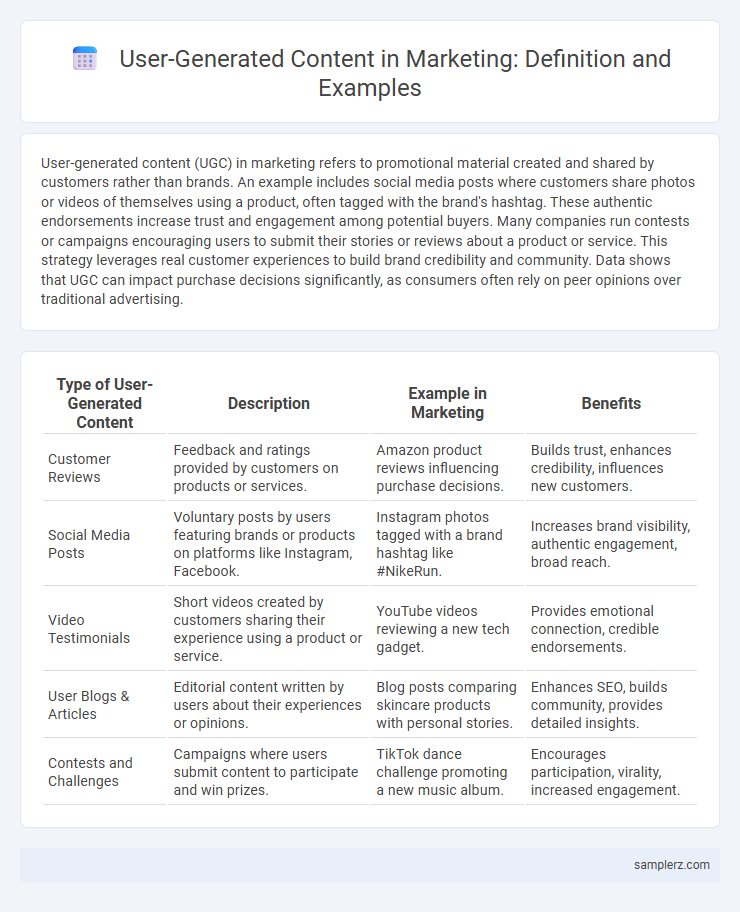User-generated content (UGC) in marketing refers to promotional material created and shared by customers rather than brands. An example includes social media posts where customers share photos or videos of themselves using a product, often tagged with the brand's hashtag. These authentic endorsements increase trust and engagement among potential buyers. Many companies run contests or campaigns encouraging users to submit their stories or reviews about a product or service. This strategy leverages real customer experiences to build brand credibility and community. Data shows that UGC can impact purchase decisions significantly, as consumers often rely on peer opinions over traditional advertising.
Table of Comparison
| Type of User-Generated Content | Description | Example in Marketing | Benefits |
|---|---|---|---|
| Customer Reviews | Feedback and ratings provided by customers on products or services. | Amazon product reviews influencing purchase decisions. | Builds trust, enhances credibility, influences new customers. |
| Social Media Posts | Voluntary posts by users featuring brands or products on platforms like Instagram, Facebook. | Instagram photos tagged with a brand hashtag like #NikeRun. | Increases brand visibility, authentic engagement, broad reach. |
| Video Testimonials | Short videos created by customers sharing their experience using a product or service. | YouTube videos reviewing a new tech gadget. | Provides emotional connection, credible endorsements. |
| User Blogs & Articles | Editorial content written by users about their experiences or opinions. | Blog posts comparing skincare products with personal stories. | Enhances SEO, builds community, provides detailed insights. |
| Contests and Challenges | Campaigns where users submit content to participate and win prizes. | TikTok dance challenge promoting a new music album. | Encourages participation, virality, increased engagement. |
Real-World User-Generated Content Campaigns
Nike's "Dream Crazy" campaign leveraged real-world user-generated content by featuring authentic stories and social media posts from athletes and everyday users showcasing their personal achievements and challenges. Coca-Cola's "Share a Coke" campaign encouraged consumers to submit photos and stories with personalized bottles, creating a massive collection of user-generated content that boosted brand engagement. GoPro thrives on real-world user-generated content by promoting customers' adventure videos, turning authentic experiences into powerful marketing assets that increase brand visibility.
Social Media Challenges Fueling Brand Awareness
Social media challenges, such as the #IceBucketChallenge and #InMyFeelingsChallenge, have driven massive user engagement while boosting brand visibility across platforms like Instagram, TikTok, and Twitter. These campaigns encourage user-generated content that fosters authenticity and widespread sharing, significantly increasing organic reach and brand affinity. Brands leveraging these viral challenges often see surges in follower growth, community participation, and overall market presence.
Influencer Collaborations Leveraging UGC
Influencer collaborations leveraging user-generated content (UGC) significantly amplify brand reach by integrating authentic customer experiences into marketing campaigns. Brands utilizing influencer-generated reviews, unboxing videos, and testimonials create relatable content that drives higher engagement and conversion rates. Platforms like Instagram and TikTok serve as critical channels for distributing influencer-created UGC, harnessing social proof to boost brand credibility and trust.
Customer Reviews Driving Purchase Decisions
Customer reviews significantly influence purchase decisions by providing authentic insights and social proof that build trust in a brand, product, or service. Studies show that 90% of consumers read online reviews before buying, with positive feedback increasing conversion rates by up to 270%. Leveraging user-generated reviews in marketing strategies enhances credibility and drives higher engagement and sales.
Hashtag Campaigns that Spark Engagement
Hashtag campaigns in marketing harness user-generated content by encouraging customers to share experiences with branded hashtags, amplifying reach and authenticity. Successful examples include Coca-Cola's #ShareACoke, which boosted social engagement by inviting users to post personalized stories, and Airbnb's #LiveThere campaign, driving community interaction through travel photos. These campaigns enhance brand visibility and foster organic connections by leveraging the creativity and enthusiasm of the user base.
Visual Testimonials: Photos and Videos from Customers
Visual testimonials, such as photos and videos from customers, significantly enhance brand credibility by showcasing authentic user experiences. These user-generated contents help potential buyers visualize product benefits in real-life scenarios, boosting engagement and trust. Brands leveraging platforms like Instagram and TikTok with hashtags collect valuable visual testimonials that increase conversion rates through social proof.
Creative Contests and Giveaways Featuring UGC
Creative contests and giveaways featuring user-generated content (UGC) amplify brand engagement by encouraging customers to submit original photos, videos, or stories that showcase their experience with the product. These campaigns increase organic reach and authenticity, as participants often share their entries across social media platforms, attracting new audiences and fostering community loyalty. Brands like GoPro and Starbucks have successfully leveraged UGC contests to generate authentic content, improve customer interaction, and boost sales.
UGC Integration in Brand Advertising
UGC integration in brand advertising enhances authenticity by featuring real customer photos, videos, and testimonials across digital campaigns. Brands like Coca-Cola and GoPro leverage UGC to create relatable content that boosts engagement and trust among target audiences. This strategy increases conversion rates by transforming customers into active brand advocates within social media platforms.
Community-Driven Content on Brand Websites
Community-driven content on brand websites leverages user-generated reviews, testimonials, and forum discussions to create authentic engagement and trust. Platforms like Sephora's Beauty Insider showcase customer photos and product ratings, enhancing social proof and encouraging repeat visits. This strategy boosts conversion rates by fostering a sense of belonging and allowing users to influence purchasing decisions directly.
Authentic Word-of-Mouth Through Unboxing Experiences
User-generated content in marketing shines through authentic word-of-mouth generated by unboxing experiences, where consumers share genuine reactions and detailed reviews on social media. Brands harness these organic testimonials to build trust and enhance product credibility, leveraging visuals and personal narratives that resonate with potential buyers. This approach boosts engagement rates significantly, driving higher conversion through relatable, user-driven storytelling.

example of user-generated in marketing Infographic
 samplerz.com
samplerz.com